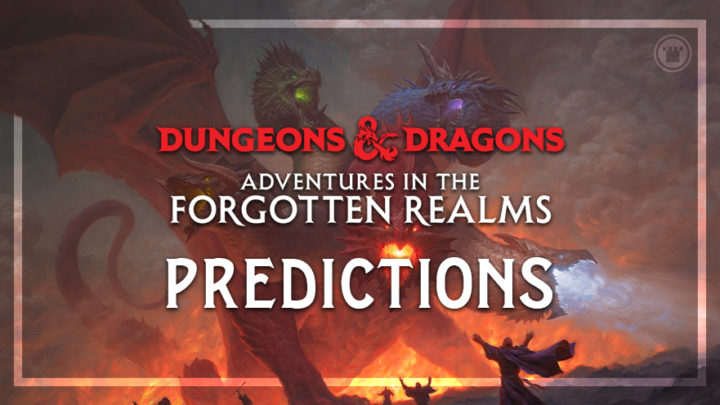Gather your party and pick up your +1 swords – Adventures in the Forgotten Realms speculation is heating up!
It’s clear that WotC has a huge list of expectations to live up to this spoiler season. For one, AFR represents the next big shakeup to Standard at a time when most players agree the format desperately needs it. But furthermore, this set seems like a proof of concept for the upcoming Universes Beyond crossover sets; it’s the first set in ages to take place outside the main Magic canon.
Sure, Dungeons & Dragons and Magic: the Gathering draw on similar fantasy sources for inspiration, are owned by the same publisher and employ many of the same artists… but that doesn’t necessarily make things easier!
SPICING UP THE FANTASY SOUP
Making something feel like a D&D adaptation first requires you to pin down what makes something feel like D&D. And since D&D and its tropes have inspired so much of Magic and other modern fantasy already, that can be quite the challenge!
For instance, giants are some of D&D’s iconic antagonists — but Magic has already done oafish, marauding Hill Giants through Lorwyn and Throne of Eldraine, as well as norse-inspired frost and fire giants in Kaldheim. Famous D&D spells like Fireball, Lightning Bolt, Teleport and Animate Dead are also already on cards. The biggest challenge of this set isn’t “how to put D&D into MTG” — it’s figuring out which parts of D&D aren’t already in MTG.
WotC’s solution seems to rely on recreating the most famous creatures, items and spells from D&D history via top-down design. A Flumph may not be that different in concept from a Gomazoa, or Power Word: Kill from Doom Blade. But those specific names carry nearly 50 years of historical weight. By deftly choosing the most evocative and suitable relics of D&D like this, WotC can turn AFR into a nostalgic masterpiece.
A CAN’T-MISS PREDICTION
Power Word: Kill in particular is an outstanding choice for this — it’s a unique name for a distinctive yet intuitive effect. But the perfect choice of D&D spell to adapt for a card would be every wizard’s trusty weapon against darkness: Magic Missile.
This spell produces one or more homing projectiles from the caster’s pure magical energy. While less powerful than other attack spells, the missiles are almost impossible to avoid or absorb. Going by the top-down design logic we’ve seen so far, Magic Missile is almost certain to be a Forked Bolt-style burn spell, perhaps losing the ability to target players in return for a “damage can’t be prevented” clause. The mana cost is likely to be as low as possible, since Magic Missile is a level one spell.
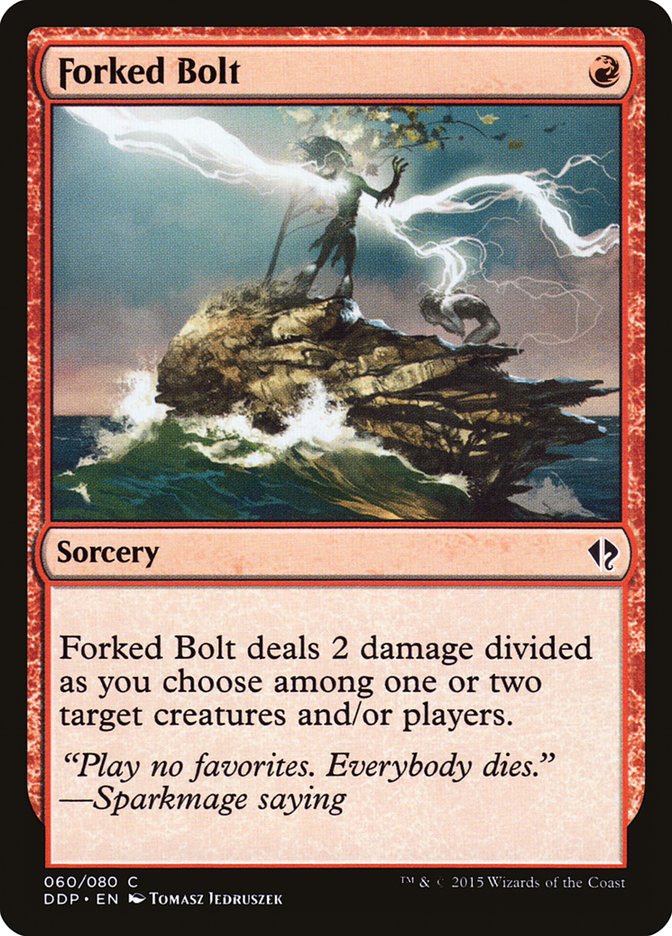
Other spells I can see appearing as cards include:
- True Resurrection: An expensive white reanimation effect
- Cure Wounds: A chance for R&D to try and redeem the Healing Salve card archetype
- Prismatic Spray: A multi-target removal spell which applies a new effect to each creature hit
- Wail of the Banshee/Circle of Death: Black creature sweepers
- Create Undead: Produce an instant army of Zombie and or Skeleton tokens, perhaps by exiling cards from graveyards as fuel
- Rope Trick: A defensive flicker effect for the whole team
- Mordenkainen’s Disjunction: Powerful removal for one or more artifacts or enchantments
- Bigby’s Grasping Hand: Temporary removal along the lines of Heliod’s Punishment
- Bull’s Strength/Cat’s Grace/Bear’s Endurance/Fox’s Cunning/Owl’s Wisdom/Eagle’s Splendor: A cycle of team-wide keyword-granting buffs, or perhaps Auras.
- Passwall: Makes one or more creatures unblockable this turn
- Planar Binding: Anti-planeswalker tech, similar to The Immortal Sun
ITEMS OF INTEREST
One distinctive trait of D&D is its adoring focus on treasure. After all, loot is what dungeons are full of and dragons protect; it’s a surefire motive for any adventurer to descend into the lethal unknown at the drop of a hat. I’m 100% sure we’ll get even more Treasure token shenanigans in AFR, but gold and jewels are really just a consolation prize for experienced D&D characters. Magical items and gear is where it’s at in fantasy roleplaying, and based on the cards we’ve already seen for Vorpal Sword and Portable Hole, it’s safe to assume WotC has cooked up a ton of new artifacts to do them justice.
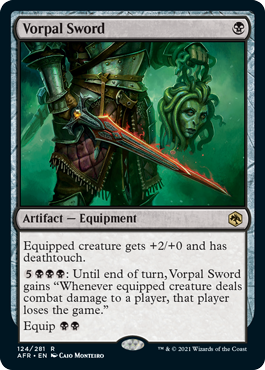
Magical items are where I see some of the greatest potential for fresh concepts to be introduced to Magic, so I would be happy to see them as a major mechanical theme of the set. Equipment in particular needs to find a healthy place in modern card design beyond outliers like Swords or Embercleave; since the card type didn’t exist in Magic’s early years where the most aggressive stealing-from-D&D occurred, iconic relics like the Holy Avenger or Staff of the Magi are still ripe for adaptation.

But even beyond the sort of wearable gear that translates easily to Equipment cards, I can still see plenty of room for small utility effects like Portable Hole. Ideally, I’d like to see these artifacts focused heavily in white and black, perhaps with some red equipment to follow on from themes in Zendikar Rising and Kaldheim. White is often the color of craftsmanship, while black is the color of greed, looting, and theft. Together, they encapsulate how D&D characters relate to magical items, and it’s an underutilized yet not-totally-alien theme for the color combination. WotC could even use some generic “for each card attached to this creature” wording on their Equipment synergy cards to allow mixing and matching with Theros Beyond Death’s WB Auras theme!
Some famous magical items which might make good artifact cards:
- Holy Avenger: A white-costed Equipment to balance out the black-heavy Vorpal Sword; can counter spells and abilities targeting equipped creatures for a cost.
- Robe of Many Things: Equipment which allows the creature to create tokens (small creatures, Treasure, Clues or Food) by tapping or perhaps attacking
- Ioun Stones: Could be an Equipment, but just as likely to be a defensive utility artifact like Witchbane Orb
- Potions/Scrolls: D&D’s staple magic consumables would fit perfectly as a cycle of Spellbomb-like one-use effects
- Deck of Many Things: This powerful, luck-based summoning artifact might work like Aetherworks Marvel, or an upgraded Druidic Satchel
- Staff of the Magi/Staff of Power: These could be similar to M20’s Retributive Wand, which features the staffs’ famous self-destruct mechanism. But I could imagine a more pushed version which mixes sacrificial removal with some incremental value akin to Staff of Domination.
- Sphere of Annihilation: This is the effect Chaos Orb originally referenced, made famous by the Tomb of Horrors dungeon crawl. Why not make a new version?
- Cloak of Resistance: There’s plenty of opportunity for good defensive items in this set. This could prevent noncombat damage or reduce each individual instance of damage like Valkmira, Protector’s Shield.
- Belt of Giant Strength: Equipment which grants extra power, trample, and the Giant type.
- Hand of Vecna/Eye of Vecna: The lich-god Vecna isn’t officially part of the Forgotten Realms canon, but he has long been D&D’s favorite meta-villain. His disembodied hand and eyeball are deeply flavorful artifacts, which can be grafted to the body of a living mage to obtain Vecna’s considerable power.
OF MONSTERS AND MEN
There’s potential for any number of nostalgic references in the spells and magic items of D&D. But that still only gets us as far as the artifacts, instants and sorceries of AFR. What about the creatures? The lands? The planeswalkers?
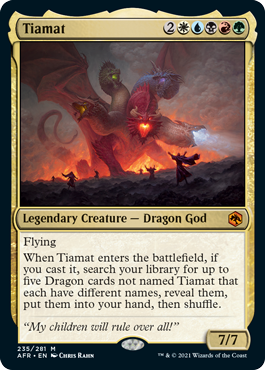
We already know that dragons will feature as a prominent part of the set after Tiamat was spoiled, along with D&D’s signature monsters like Flumphs, Beholders, Illithids (a.k.a. Mind Flayers), Displacer Beasts, Umber Hulks and Rust Monsters. The text of Power Word Kill further hints that this set will include some of the famous devils, demons, angels and archons of D&D lore — bearded devils, ice devils, mariliths and the like.
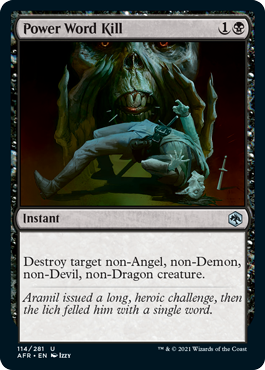
But not every creature in the set can be a giant monster. We will no doubt get the full gamut of Humans, Elves (including Drow), Dwarves, Aasimar, Tieflings and Halflings to fill out the mana curve in each color. I’m also hoping this set will give underutilized tribes like Orcs and Kobolds more support, and perhaps even feature other humanoids from D&D’s past like Gnolls (hyena-people) and Kuo-Toa (frog/fish-people).
One thing I’m curious to see with these humanoid creatures is how the different “job types” are distributed. On the one hand, this seems like the perfect opportunity to support the slightly underpowered party mechanic, which requires Clerics, Wizards, Rogues and Warriors — the classic D&D lineup. But we can also see from the spoilers that WotC has added the Ranger class as its own creature type, just like Warlocks were split off in Eldraine. This leaves Sorcerer, Bard and Paladin as the only classes not represented in Magic. But if WotC goes through with printing those creatures as their own types, that means fewer Wizards, Rogues and Warriors to interact with party cards. It’s an unfortunate flavor-mechanics mismatch — and perhaps the best way around it is just some good old fashioned multi-typing. If we can have a Centaur Druid Scout Archer in the game, surely we can manage an Aasimar Warrior Cleric Paladin?
FINISH WITH SOME STAR POWER
Every set these days needs to have a good number of named legendary cards, and this is where the Forgotten Realms part of AFR comes in. Toril, the world on which Forgotten Realms stories occur, has a vast canon told through sourcebooks, adventure modules and fantasy novels — plenty of inspiration for the various factions and legendary figures which can put the cherry on this crossover cake.
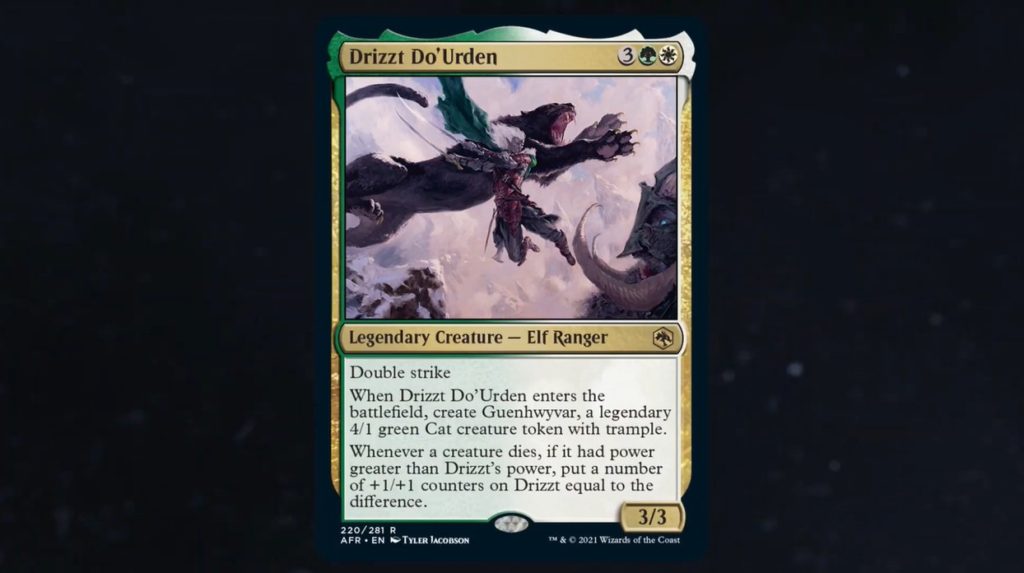
Drizzt Do’Urden is essentially the mascot of the Forgotten Realms, starring in a lengthy series of heroic fantasy adventures from the pen of R. A. Salvatore. The heroic Drow Elf was such a shoe-in for this set that WotC just went ahead and spoiled it immediately! But of course, no D&D hero adventures alone, and we’ve now also seen the card for one of Drizzt’s long-time companions: dwarven king Bruenor Battlehammer.

That makes it almost certain that we’ll see Bruenor’s adopted human daughter Cattie-Brie, mercurial barbarian Wulfgar, and urbane halfling Regis join the party. Perhaps they’ll all be bundled into the Naya shard, since what’s the point if you can’t play them in the same deck? If WotC wants to expand the cycle further, I expect we’ll see some of Drizzt’s most famous and enduring foes as well: magic-hoarding drow mercenary Jarlaxle, the ambitious assassin and duelist Artemis Entreri, the possessed crystal shard Crenshinibon, and the great orc king Obould Many-Arrows could fill out some of the black-based color combinations.
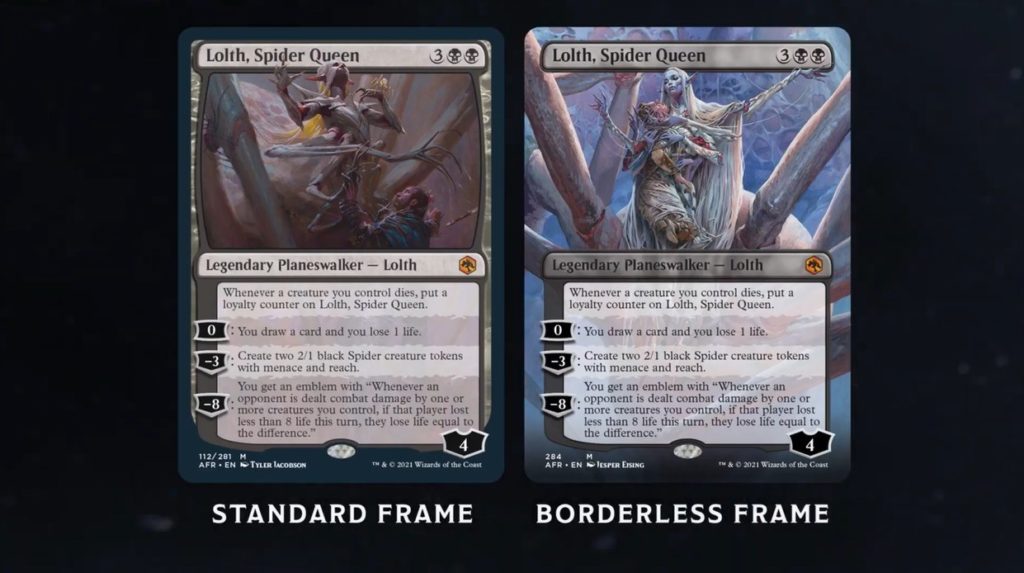
Another alumnus of Salvatore’s books to appear in the early spoilers is Lolth, Spider Queen — the only planeswalker card revealed so far. Since the lore around planeswalkers and their “spark” is only canon within the Magic Multiverse, WotC has confirmed that AFR (and any future Universes Beyond products) will use the card type more abstractly to represent beings with a divine level of power. Lolth, one of D&D’s most infamous evil deities, makes a perfect fit. But WotC also spoiled another dark god, Tiamat, as a legendary creature! This seems like a distinction based on their role in the lore; Lolth is much more of a manipulator behind the scenes, scheming and influential.
By this metric, I would predict the next planeswalker card we see to be Elminster, Sage of Shadowdale. This all-powerful archmage is the official self-insert character for the creator of Forgotten Realms, Ed Greenwood, and he also stars in a long line of novels. Thanks to the limitless potential of his magic (and Greenwood’s editorial control over the Forgotten Realms), Elminster’s adventures have seen him shape the entire history and character of Toril. He has traveled through time, he’s been imprisoned in Hell, and he even canonically broke the fourth wall to visit Ed Greenwood’s house!
Elminster’s status and complex role in the history of Forgotten Realms is comparable to that of Urza in Magic lore. I’d expect Elminster to appear as a five-color planeswalker, demonstrating his supreme mastery of all magic. A WUBRG Elminster would also be the perfect opportunity to print a centerpiece for a “five-color legends” deck archetype, which would tie into existing Standard cards like Esika, God of the Tree or Kolvori, God of Kinship.
WHAT ABOUT THE VOICE BEHIND THE SCREEN?
One of the most difficult yet in-demand D&D cards would be a meta-reference to the role of the Dungeon Master, perhaps tied in with a reference to “godfather of roleplaying” E. Gary Gygax. WotC actually created a Dungeon Master card as one of their uber-rare employee promos, but there’s always the chance to figure something out — perhaps using “Dungeon Master” as the title for a legendary creature, or making a card for Gygax’s own personal player character, Mordenkainen the Mage. However, the two most natural concepts for this card would be a black or five-color planeswalker — slots which may already be taken in this set. And while few would object to a Gygax homage in the D&D set, neither he nor Mordenkainen have connections to Forgotten Realms, specifically.
So, what could be the compromise which gets both D&D’s revered creator and the old-school stereotype of a capricious, deadly dungeon master into AFR? There’s one really strong candidate who ticks all the boxes, and that’s another famous lich: Acererak the Eternal. Acererak is himself a perfect bridge between D&D’s distant past and booming present, between the early creations of Gygax and the current “default” setting of Forgotten Realms.
He is the final boss of D&D’s most meta-famous, absurdly lethal dungeon crawl, the Tomb of Horrors. This adventure module was written by Gygax himself for the first ever Origins convention in 1975, and since its purpose was to challenge entrants in a “D&D Tournament,” he made sure it was a brutal killing field of traps and monsters. Almost every room and challenge from the Tomb has entered roleplaying game lore in some way, and it has been repeatedly remade — including a spiritual sequel for the current edition of the game, Tomb of Annihilation, which sees Acererak set up a new dungeon base to threaten the Forgotten Realms!
Acererak is a perfect stand-in for the “Dungeon Master” figure, in part because he famously does not appear to fight invaders to most of his deathtrap dungeons. Instead, he remains a literal legendary creature, a catchy name to plaster onto old-school adventure design like the patron saint of party wipes. In a perfect world, I imagine Acererak the Eternal as a legendary modal double-faced card: expensive Lich creature on the front, legendary “Tomb of Horrors” utility land on the back. I think playing a (non-mana-producing) land from the Command Zone offers some cool design space, and a selection of increasingly costly activated abilities would make it a perfect mana sink for a mono-black control archetype in Constructed. Just imagine playing a Modern event and tapping Cabal Coffers to fuel your Tomb of Horrors with overflowing black mana! Those are the kind of cool crossover vibes that a set like AFR should aim to enable.
FROM REALMS FORGOTTEN TO UNIVERSES BEYOND
There’s so much to unpack just in the idea of a Forgotten Realms crossover set, and the spoilers themselves are almost upon us already. AFR could set a vital new precedent in storytelling and card design, as WotC seeks the middle ground between what we expect from the game and the tone of outside IPs.
While I’m uncertain about how those future sets will work out, I’m happy to watch WotC approach this new direction one step at a time. And for so natural a crossover as Magic and Forgotten Realms, this set seems to have found solid, exciting ground under its feet.

Tom’s fate was sealed in 7th grade when his friend lent him a pile of commons to play Magic. He quickly picked up Boros and Orzhov decks in Ravnica block and has remained a staunch white magician ever since. A fan of all Constructed formats, he enjoys studying the history of the tournament meta. He specializes in midrange decks, especially Death & Taxes and Martyr Proc. One day, he swears he will win an MCQ with Evershrike. Ask him how at @AWanderingBard, or watch him stream Magic at twitch.tv/TheWanderingBard.

